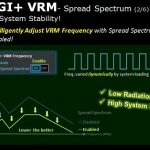ASUS’ has always been a company that adds new kit to each generation of motherboards. It’s latest P8P67 series motherboards are no exception to this trend, with the addition of Dual Intelligent Processors 2 and its complementary DIGI+ VRM.
You may already be familiar with the ‘Dual Intelligent Processors’ name from the previous P7P55/P7H55 series motherboards that use the same EPU and TPU processors, which manage energy use and performance. However, this time around ASUS has tied them together with an additional microprocessor to create a more elegant arrangement, that better works with both.
DIGI+ VRM
This can only happen thanks to the other change ASUS has upgraded the system with: its DIGI+ VRM. This new tech exchanges the old, analogue power regulation for the CPU socket, with the latest in fully digital technology. While the old technology has come a long way in the many years it’s been used, digitizing the power hardware not only gives ASUS a bump in power driven per phase, but also allows more acute, on-the-fly changes.
The DIGI+ VRM controller is actually a programmable micro-processor that can accurately match and manipulate multiple PWM signals, without any power transfer loss, thus making the system overall less wasteful.
Spread Spectrum – Better Left On?
With this finesse it can also modulate the VRM frequencies to offer a better spread spectrum too. Normally we turn this function off in the BIOS because it competes with the purity of overclocking, but the new controller can simultaneously provide ample power as well as compensate for electromagnetic interference generated by power spikes. For the first time then, leaving spectrum spread on should actually mean more stable overclocking!
TPU
Now back to the two other chipsets: the TPU that manages these power phases can be left to handle them automatically, using the optimum presets determined through extensive testing by ASUS engineers, however set to its manual mode and overclockers will get a never before seen range of options and level of control: think 10k Hz step adjustments in factors like phase control, VRM frequency, and new changes in VRM Duty cycle, load-line calibration and current capacity that were simply ‘on’ or ‘off’ options before. That’s hardcore stuff performance enthusiasts can truly revel in!
Admittedly the downside is that these will take some re-learning and understanding of how VRM frequency relates to voltage and power, but that’s part of the fun: what Intel taketh away in base clock control, we get back from ASUS in power management and manipulation.
EPU and TPU now work together, better than ever.
On the other side of things, it’s no longer necessary to choose between TPU overclocking and EPU power management too – the DIGI+ VRM can balance both and finally let the EPU do its job while us overclockers get our extra MHz. Since the DIGI+ VRM can be so precisely modulated, the old efficiency curve that bounced up the steps of phase use (2 to 4 to 6/4 to 8 to 16 etc) is no longer true – instead it’s a gentle, continuous curve.
Like before, the EPU can also extend its reach to memory, chipset, hard drives, fan control and graphics card, and as a hardware IC it can work faster, regardless of OS and more acutely thanks to direct BIOS control.
Overall, Dual Intelligent Processors 2 and the DIGI+ VRM hardware might appear evolutionary at first but actually it’s a revolutionary change that goes hand-in hand with Intel’s revolutionary new approach to CPU-GPU design in Sandy Bridge. ASUS is so confident about it it’s used it across every P8P67 motherboard (except, one budget model). Now we only have to wait a short while longer to actually test it!







